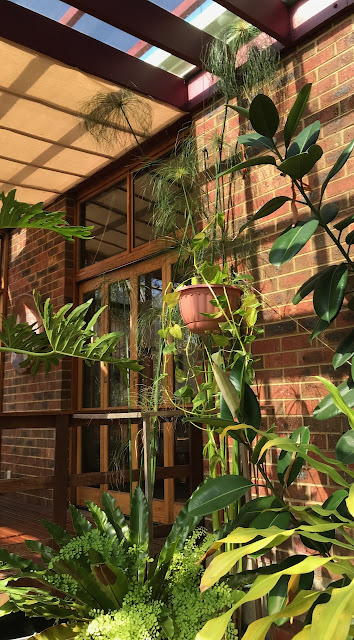Two weeks ago I set my senior Melbourne students the fairly traditional exercise of making an ikebana using Autumn grasses, arranged in a basket.
Eugenia collected all the materials from her garden, which has quite a number of Australian native species. However, her ikebana also has exotics including variegated New Zealand Flax Phormium.
Jacqueline collected her materials from the wayside. The grass with the plume-like flowers on the right looks like Fountain grass Cenchrus setaceus, a native of Africa, the Middle East and South-western Asia. Her 'basket' is woven from Pandanus leaves and can sit flat, or the edges can be lifted and held by toggles at the corners.
In the garden, the Haemanthus coccineus recently produced five flowers. I decided I could afford to pick three. I justified this to myself as it would encourage the relatively young plants to put more energy into root and leaf development instead of making seeds.
I placed three flowers in a black ceramic vessel from Seto, in Japan, which looks to me rather like a strange cast-iron cooking pot. The flowers needed some green materials, so I used two Papyrus flower heads.
Earlier in the year I had transplanted the Papyrus into a small 90cm diameter garden pond in the conservatory. By the early summer the tallest stems were 3.5m long, touching the ceiling glass. Two of the stems had bent and collapsed, so I used them in my ikebana.
This was the first version of the ikebana. I had to tie up the rays (the fine filaments) at the top of the smaller stem on the left because they hid the flowers completely. Having done that, the papyrus stems looked too different to each other.
I then loosely tied the rays on the taller stem to create a more coherent appearance in the arrangement. Standing back, I felt the idea of using the Papyrus made an "interesting" experiment but not a successful ikebana.
Since then I made another ikebana arrangement where I was happy to let the rays of a drying Papyrus flowerhead cascade over other elements.
This is my third version using a Papyrus flowerhead in this way. I made the arrangement for an Ikebana International Melbourne workshop last Saturday. The workshop theme was "Using roses in ikebana". I find hot-house grown roses a very difficult material because of the stiffness of the stems and the weakness of the leaves. In the ikebana above I used roses bought from a florist with which I created a mass in the centre. The fine rays of Papyrus cascade over the three pale pink roses. The dried parts in the centre of the Papyrus closely matched the soft pink of the roses. I placed a dried, sun-bleached branch of Moonah Melaleuca lanceolata curling around the vessel and extending to the left. The roses have become a small colour focus that contrasts with the strong line of the dried branch.The vessel is by the Victorian ceramicist Terunobu Hirata.
Greetings from Christopher
12th April 2025


















.jpeg)





